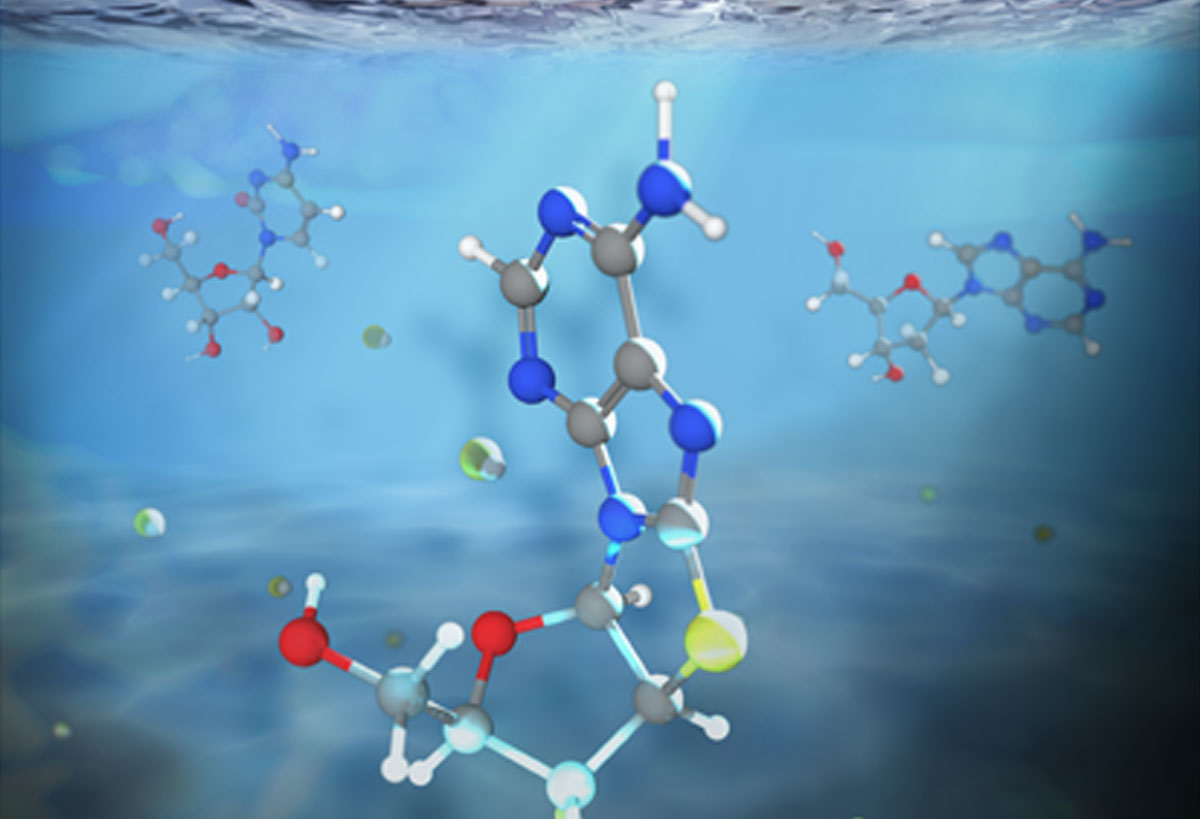New research suggests that early informational polymers might have been formed from DNA and RNA building blocks at the dawn of life

The origin of life and the nature of the first genetic polymer is the subject of major debate. One of the theories – the RNA world theory – suggests that RNA was the first replicable information carrier at the dawn of life whereas other evidence implies that life may have started with a heterogeneous nucleic acid genetic system comprising mixed RNA and DNA. The latest research from LMB scientists supports the latter idea.
LMB scientists Jianfeng Xu, Václav Chmela, Nicholas Green, and David Russell from John Sutherland’s Group and others, including theoreticians led by Rafal Szabla at Edinburgh University, conclude that reasonable amounts of the building blocks of such a heterogenous genetic material may have been available on primordial Earth.
Starting with a mixed RNA-DNA nucleic acid streamlines the eventual ‘genetic takeover’ of homogeneous DNA from RNA as the principal information storage molecule in the central dogma, but requires a selective abiotic synthesis of both RNA and DNA building blocks in the same local primordial geochemical scenario. The central dogma, which was proposed by Francis Crick, emphasizes that the flow of genetic information from the nucleic acids, DNA and RNA, to make proteins is a one way process.
How do scientists create early solar system conditions in a lab?
UV (mercury) lamps were used for the key photoreduction step, which simulated the early sun’s solar output reaching the surface of Earth, driving key reactions essential for the origin of life. The reactants were dissolved in water, then dried down and heated. This dried mixture is then dissolved in water before being irradiating with UV light, to simulate conditions on a rocky planet like Earth.
Purines and pyrimidines are the two different kinds of nucleobases in DNA and RNA. Adenine (A) and guanine (G) are purines and cytosine (C), thymine (T) and uracil (U) are pyrimidines. Purine-pyrimidine base pairs (A with U or T and C with G) are key to information transfer. Ribonucleosides have a nucleobase attached to the sugar ribose whereas in deoxyribonucleosides the sugar is deoxyribose.
The researchers demonstrated a high-yielding, completely stereo-, regio-, and furanosyl-selective prebiotic synthesis of the purine deoxyribonucleosides, deoxyadenosine and deoxyinosine. Deoxyadenosine is one of the naturally occurring, or canonical purine deoxyribonucleosides, deoxyinosine is not but is thought to be able to take the place of the canonical deoxyguanosine.
Their synthesis utilised key intermediates in the prebiotic synthesis of the pyrimidine ribonucleosides, cytidine and uridine. The paper shows that, once generated, the pyrimidine ribonucleosides persist throughout the synthesis of the purine deoxyribonucleosides suggesting that two DNA building blocks may have coexisted with two base pairing RNA partners at the dawn of life.
John, who is a group leader in the PNAC Division, explains, “The nucleic acids, RNA and DNA are clearly related and this work suggests that they both derive from a hybrid ancestor rather than one preceding the other. Guided by Crick’s central dogma, we now need to uncover how the sequential information which can be stored and purveyed by these nucleic acids was first transferred to proteins.”
This research was funded by UKRI MRC, the Simons Foundation, the National Science Centre Poland, the Polish Ministry of Science and Higher Education, and the Wrocław Centre of Networking and Supercomputing.
Further references:
Selective prebiotic formation of RNA pyrimidine and DNA purine nucleosides. Xu, J., Chmela, V., Green, NJ., Russell, DA., Janicki, MJ., Góra, RW., Szabla, R., Bond, AD., Sutherland, JD. Nature 582: 60-66.
John’s group page
News and Views: How DNA and RNA subunits might have formed to make the first genetic alphabet
Previous Insights on Research
Prebiotic chemistry shows how DNA building blocks might have arisen at the origin of life
Common origins of RNA, proteins and lipids on Earth